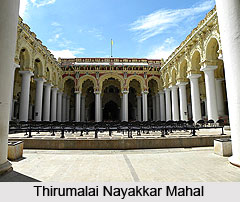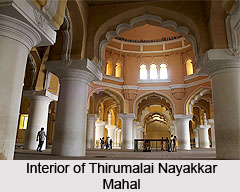 Thirumalai Nayakkar Mahal was built by King Thirumalai Nayak who used to rule over Madurai in 1636 AD. This palace was built by an Italian architect who brought out some of the rarest architectural skill. The palace depicts a classic fusion of Dravidian, European and Islamic style of architecture. Often known as the Wonders of South his is one of the largest palaces of Madurai. It is said that the original palace was about four times larger than the one which is existing now. The present palace is only a part of the original palace. Mainly known for its architecture this palace is located in the city of Madurai. This palace stands majestically at a distance of 2 kms from the Meenakshi Amman Temple.
Thirumalai Nayakkar Mahal was built by King Thirumalai Nayak who used to rule over Madurai in 1636 AD. This palace was built by an Italian architect who brought out some of the rarest architectural skill. The palace depicts a classic fusion of Dravidian, European and Islamic style of architecture. Often known as the Wonders of South his is one of the largest palaces of Madurai. It is said that the original palace was about four times larger than the one which is existing now. The present palace is only a part of the original palace. Mainly known for its architecture this palace is located in the city of Madurai. This palace stands majestically at a distance of 2 kms from the Meenakshi Amman Temple.
During 17th century Madurai had been a major trading centre which was visited by the Portuguese, Dutch and other Europeans who landed up as either missionary or as travellers. As such the king employed all these people and an Italian architect to design this massive palace. Thirumalai Nayakkar Mahal is mainly known for its architectural marvel. The design of the palace includes the architecture of Dravidian, Islamic and European style. The palace includes a massive courtyard which extends upto 3700 sq. kms. The visitors enter into a huge courtyard which is surrounded with circular pillars.. The pillars are mainly decorated with Indo saracenic architecture in India. The palace is divided into two major parts namely Swarga Visalam and Ranga Visalam. While the Swarg Visalam was used as throne room which has an arched octagon covered by a dome that is 60 - 70 ft high.
 The Ranga Visalam includes a theatre, shrine, apartments, armoury, palanquin place, royal bandstand, quarters, pond and garden which was situated in these two portions. The courtyard and the dancing hall are some of the major attractions of the palace.
The Ranga Visalam includes a theatre, shrine, apartments, armoury, palanquin place, royal bandstand, quarters, pond and garden which was situated in these two portions. The courtyard and the dancing hall are some of the major attractions of the palace.
Thirumalai Nayakkar Mahal is one of the well maintained palaces in India. The walls of the palace is polished with high quality of Chunam mixed with egg shell and lime which gives a shiny and smooth look. Surrounded with 20m tall pillar this palace has well decorated arches that add to the beauty of the courtyard. The palace represents some of the most attractive piece of Nakashi which depicts the influence of Islamic architecture on the construction of the palace. Presently the palace is one of the legendary monuments of India. This has been under the supervision of Tamil Nadu Archeological Department. The time to visit the palace is between 9.00am to 5.00pm. Presently the biggest attraction of the palace is the light and sound show which is organised in the palace. It depicts the story of Silapattikaram in both English and Tamil version. As it is located at the centre of Madurai city it is well connected with roadways and railways that make easily accessible for bits visitors.
Thus with some exclusive architecture this palace stands majestically at the heart of Madurai city. This mainly attracts the visitors with the arches and pillars which are decorated in typical style of Indo sarsacenic Dravidian architecture. The huge dome and corridors are some of the most remarkable feature of the palace along with some exclusive antique pieces like statues of gods and goddesses and the king and his wives which attract everyone who visit the place.



















